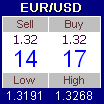You are here
Buying/Selling
Example of How Buying/Selling Works |
|
|
Just like in all markets, there are two prices for every currency pair. The difference between these two prices is the spread, or the cost of the trade. In this example, the spread is three pips. On a mini account, a pip on the EUR/USD currency pair is worth $1. |
 |
Margin
The margin deposit is not a down payment on a purchase of equity, as many perceive margins to be in the stock markets. Rather, the margin is a performance bond, or good faith deposit. The margin requirement allows traders to hold a position much larger than the account value.
Example of How Margin Works
Since the trader opened 1 lot of the EUR/USD, his margin requirement or Used Margin is $1000. Usable Margin is the funds available to open new positions or sustain trading losses. If the equity (the value of his account) falls below his Used Margin due to trading losses, his position will automatically be closed. As a result, the trader can never lose more than he/she deposits.
